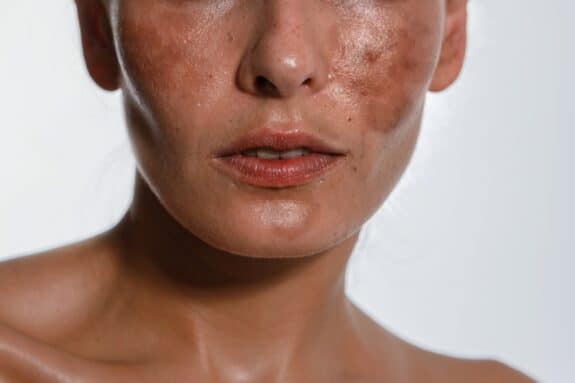Pregnancy is an amazing and fulfilling experience for many women, but it also comes with a range of changes in the body. One of these changes can be the pregnancy mask or melasma in pregnancy, a type of hyperpigmentation that occurs in some expectant mothers. A pregnancy mask can be challenging to deal with, but it is possible to minimize its symptoms and prevent its formation.
We will look at what a pregnancy mask is and what causes it, how to identify it, tips for caring for your skin during pregnancy, dermatological practices to minimize its appearance, natural remedies, and when to seek medical advice if you experience symptoms of a pregnancy mask.
What is a Pregnancy Mask, and what causes it?
A pregnancy mask, also known as chloasma or melasma, is a type of hyperpigmentation that usually appears on the face, specifically the cheeks, nose, chin, and forehead. It can also appear on other parts of the body, such as the arms and neck. The mask is caused by hormonal changes during pregnancy that causes the overproduction of melanin, which provides the skin with color. Too much melanin can lead to the formation of brown patches on the skin. Around 50-70% of women experience hormonal-related hyperpigmentation during pregnancy.
How to identify a Pregnancy Mask
A pregnancy mask is characterized by brownish, blotchy patches on the skin, usually on the face. The patches may be symmetrical or asymmetrical, and they may extend to the neck and arms in some cases. They can develop gradually, starting during the first or second trimester, and can worsen with sun exposure.
Tips for caring for your skin during pregnancy
Caring for your skin during pregnancy can help minimize the appearance of a pregnancy mask.
- Always use broad-spectrum sunscreen with at least SPF 30 whenever you go out during the day, even if it is cloudy.
- Wear a wide-brimmed hat or use an umbrella to minimize sun exposure
- Keep your skin moisturized to reduce dryness and irritation
- Use chemical-free and fragrance-free skin care products that are safe for pregnant women.
Natural remedies to minimize the symptoms of a Pregnancy Mask
Several natural remedies may help improve the appearance of a pregnancy mask, such as:
- Aloe vera is known for its soothing and healing properties
- Cucumber slices that can cool and hydrate the skin
- Lemon juice promotes skin exfoliation and lightens the skin tone.
Will it go away after you have your baby?
The good news is that pregnancy melasma is usually temporary and will often go away on its own within a few months after delivery. In some cases, the pigmentation may linger for longer than expected or even become permanent, so it’s always best to speak with a dermatologist if you have any concerns.
Best Dermatological Practices To Prevent The Appearance Of a Pregnancy Mask
There are several dermatological practices that you may consider to prevent or minimize the appearance of a pregnancy mask. These include:
- Chemical peels can effectively remove the top layer of damaged skin and improve the appearance of the skin
- Microdermabrasion uses a special wand to polish and resurface your skin
- Laser treatments target pigmentation and reduce its appearance.
It is important to talk to your dermatologist or healthcare provider before undergoing any of these treatments, especially when pregnant.
When to seek medical advice if you are experiencing symptoms of a Pregnancy Mask
While a pregnancy mask is generally harmless, it is essential to watch out for any changes in appearance, especially if they are accompanied by symptoms like itching or burning. If you experience any unusual symptoms or discomfort, you should seek medical advice from your healthcare provider or dermatologist.
Pregnancy masks are common, but they can be distressing to pregnant women because of their appearance. Hormonal changes during pregnancy are mostly responsible for their formation, and symptoms can be minimized by following the tips mentioned above. If the appearance of the mask is bothering you, always remember that there are many treatments that you can consider under the guidance of a dermatologist or healthcare provider.
Related Articles:







